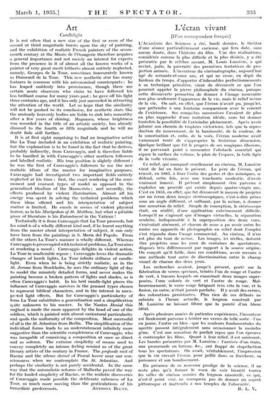Art
Candlelight
IT is not often that a new star of the first or even of the second or third magnitude bursts upon the sky of painting, and the exhibition of realistic French painters of the seven- teenth century at the Musee de l'Orangerie therefore acquires a general importance and not merely an interest for experts from the presence in it of almost all the known works of a painter of very great merit hitherto almost entirely neglected, namely, Georges de la Tour, sometimes inaccurately known as Dumesnil de la Tour. This new aesthetic star has many features in common with his astronomical counterparts : he has leaped suddenly into prominence, though there are certain acute observers who claim to have followed his less brilliant course for many years past ; he gave off his light three centuries ago, and it has only just succeeded in attracting the attention of the world. Let us hope that the similarity will not be pushed to its conclusion, for aesthetic stars like the unsteady heavenly bodies are liable to sink into nonentity after a few years of shining. Magnasco, whose brightness was recorded in the title of an artistic society, has already dimmed to the fourth or fifth magnitude and he will no doubt fade still further.
It is at first sight surprising to find an imaginative artist like La Tour included in an exhibition of realistic painting, but the explanation is to be found in the fact that he derives, probably indirectly, from Caravaggio, and is therefore liable to be bundled in with Caravaggio's other northern followers and labelled realistic. His true position is slightly different : he was the first of Caravaggio's followers to use the new realistic idiom of the master for imaginative purposes. Caravaggio had investigated two important fields entirely neglected at his time: first, the exact rendering of the com- monest and coarsest types of model as opposed to the generalized idealism of the Mannerists ; and secondly, the effects produced by violent illumination. Almost all his energy was spent in solving the technical problems which these ideas offered and his interpretation of subject matter is limited. He excels in scenes of violent physical horror, as in his Martyrdom of St. Matthew, but what a pitiable piece of literature is his Entombment in the Vatican !
Technically it is from Caravaggio that La Tour proceeds, but his mind is of a wholly different kind and, if he learnt anything from the master about interpretation of subject, it can only have been from the paintings in S. Maria del Popolo. From all the others La Tour's manner is wholly different. Whereas Caravaggio is preoccupied with technical problems, La Tour aims at rendering a mood ; Caravaggio delights in violent action, La Tour in unalterable repose ; Caravaggio loves the dramatic changes of harsh lights, La Tour infinite stillness of candle- light. Even when he is being strictly realistic, as in the St. Jerome from Stockholm, he uses the ordinary light of day to model the minutely detailed forms, and never makes the painting become a broken pattern of lights and shades, as is often Caravaggio's habit. In his todsi 'Candle-light pieces the influence of Caravaggio survives in the peasant types chosen to represent biblical characters, and in the interest in unex- pe2ted light effects. But for Caravaggio's, particularity of form La Tour substitutes a generalization and a simplification q cite unknown to his master. In the Nantes Denial this me.thod is made the more apparent by the head of one of the soldiers, which is painted with almost caricatural particularity and spoils the uniformity of the composition. Most successful of all is the St. Sebastian from Berlin. The simplification of the individual forms leads to an understatement infinitely more suggestive than the scientific completeness of Caravaggio, who was incapable of conceiving a composition at once so direct and so solemn. The extreme simplicity of means used to convey completely an intense feeling remind us of the great literary artists of the century in France. The profonde suit of Racine and the silence &mei of Pascal hover near our con- sciousness when we contemplate the St. Sebastian. And perhaps the similarity is not purely accidental. In the same way that the naturalistic reforms of Malherbe paved the way for the loaded simplicity of Racine, so the realistic discoveries of Caravaggio made possible the deliberate calmness of La Tour, so much more moving than the gesticulations of his


























































 Previous page
Previous page